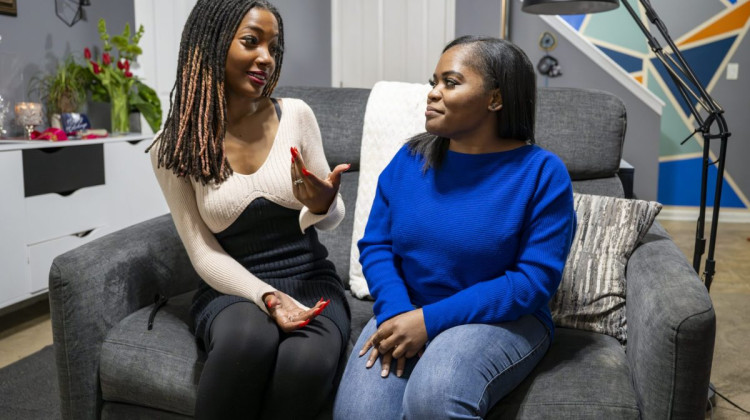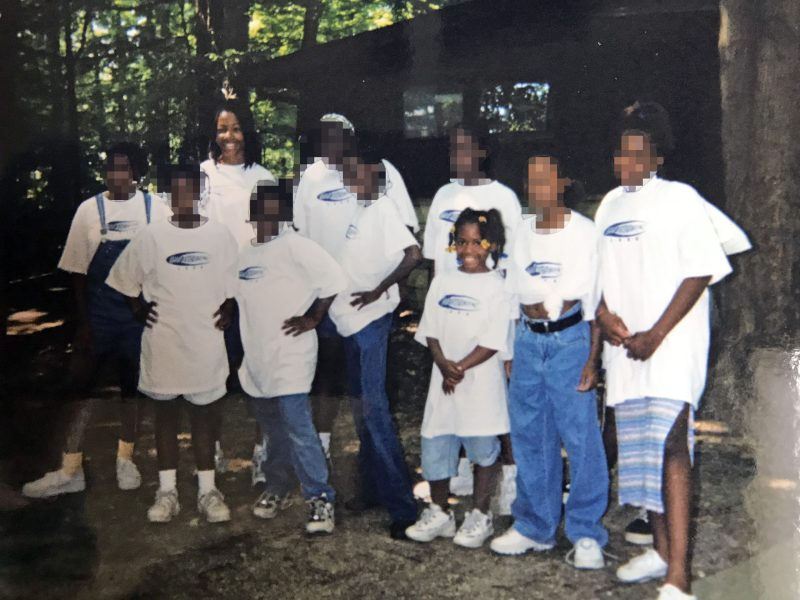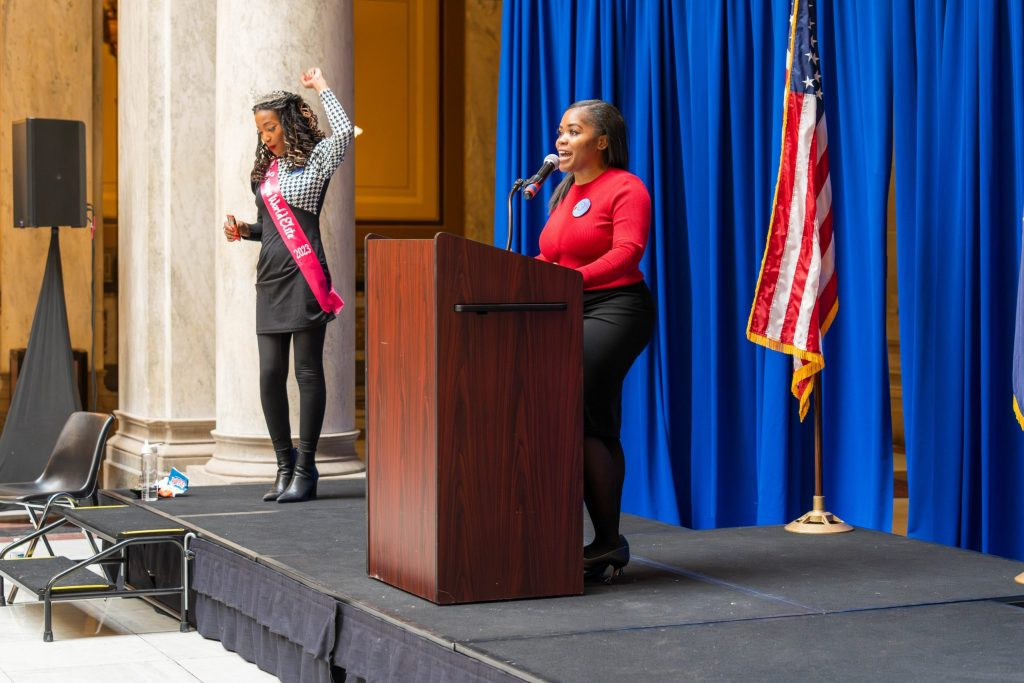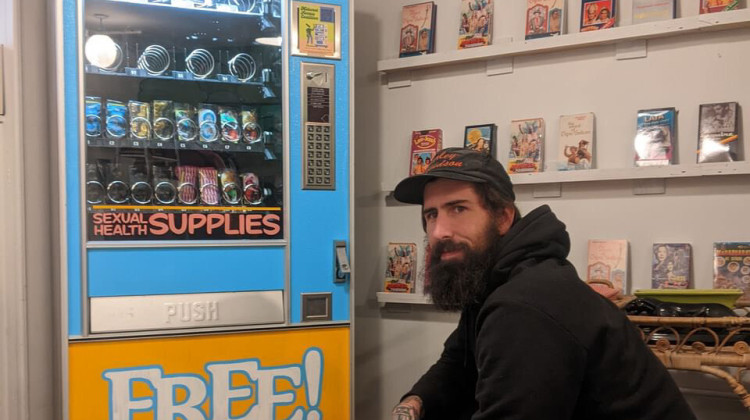
Sickle cell patients, Lena Harvey (left) and Jade Parker-Dinkins, sickle cell nurse navigator, pose for a photo, Tuesday, Jan. 23, 2024, in Indianapolis.
Doug McSchooler for Mirror IndyMary Claire Molloy, Mirror Indy
Lena Harvey lived in her bed.
The world kept moving as she sank beneath the weight of heated blankets, hazy from the pain of a rare blood disorder and the drugs meant to dull it.
Her best friend, Jade Parker-Dinkins, would come by her Pike Township home with snacks and jokes. But it was getting harder and harder to sit up, even for her.
“It’s depression,” Lena said. “Realizing you’re being snuffed out by your own blood.”
That’s the reality for 100,000 Americans who live with sickle cell disease — a chronic blood condition that primarily affects Black people. Red blood cells become rigid, blocking blood flow to the rest of the body. The pain is excruciating. Left unchecked, the disease can cause complications like stroke, kidney disease, blood clots and organ failure.
At 31, Lena started drafting her will. What would life look like after she was gone?
Flowers, she decided. Her estate would send flowers to her husband and Jade for all the anniversaries and birthdays she missed. She would entomb her love in petals and voice recordings.
‘I was afraid of dying young’
They met at sickle cell camp at Bradford Woods, Indiana University’s outdoor recreation center.
There was horseback riding, toad catching and late night bunk chats — but also doctors on stand-by with oxygen tanks and morphine. In games of tag, it was patients vs. white lab coats. Children played, briefly forgetting the fragility of their bodies, how they could shut down at the slightest overexertion.
For the first time in their lives, Lena and Jade felt free. Monitored, but free.
You can see it in an old camp photo: Eight-year old Jade has yellow flower clips in her braids and a big grin. Lena, 14, towers over her in the back left of the frame.

They eventually fell out of touch. But sickle cell disease, which affects about 1,700 Indiana residents, has a way of bringing people together.
Decades later, the two women looked back and laughed.
“We’re geriatric now,” Lena joked, sitting next to Jade in her living room.
It was true. Most sickle cell patients are lucky to make it to 50. Before mandatory screenings, babies died without their parents knowing what was wrong. Jade and Lena had made it through the most fragile years. But that didn’t mean they were unscathed.
“I was afraid of dying young,” Jade said.
One incident burns bright in her mind, even today.
She was about 11 years old. All of her friends were swimming, but she was stuck by the pool’s edge.
With a deep breath, she braved the cold water. And then her joints locked up. She sank.
A sickle cell crisis can be triggered by even the smallest of changes in lifestyle or environment, including cold weather, stress, dehydration or strenuous exercise.
A lifeguard fished Jade out and sent her to the emergency room. It was another reminder, she said: “I am not normal.”
Jade rotated in and out of the classroom at Pike High School, missing weeks of homework and friendships when a crisis hit. It felt impossible to explain what was going on to her classmates, so she didn’t.
At Lawrence North High School, Lena lived in similar isolation. People treated her differently after she revealed her condition.
“When I share with my white friends that I have sickle cell and explain what it is, I see the relief in them. They know it as a Black disease,” she said, eyes sharpening.
But her Black peers knew the prognosis all too well. Some of them had lost family members to it.
“That’s their trauma,” Lena said. “They don’t want to be my friend, because, ‘Is she going to die, too?’”
Suspicion and stigma
Gary Gibson knew just what to do.
As the president of the nonprofit Martin Center Sickle Cell Initiative, he’d met many Indianapolis patients over the years. He watched Jade become a nurse and Lena become a mom. They were fierce, high-achieving advocates. It only made sense to reconnect them at a 2018 sickle cell conference.
Lena and Jade started sharing their stories in the hopes that people with power would care like they haven’t before.

Sickle cell was discovered more than 100 years ago and has killed more than 25,000 Black Americans, but only four drugs have been developed and approved to treat it. Cystic fibrosis, a similar disease, affects fewer people, but a 2020 study notes that federal funding and donations surpass $10,000 per patient, compared to just $943 for sickle cell.
Cystic fibrosis patients can also remain on Indiana’s supplemental insurance coverage for children with serious medical conditions for the rest of their lives, while sickle cell patients are kicked off as soon as they turn 18.
One big difference? Cystic fibrosis patients are 91% white.
“If it’s something that doesn’t affect your population, there can be stigma,” said Kisha Hampton, a sickle cell advocate with Indiana Hemophilia & Thrombosis Center.
Her team hears the same story over and over again: doctors and nurses in local emergency rooms don’t understand sickle cell crises or take them seriously, leaving patients in prolonged pain.
One study found that sickle cell patients wait two hours or longer for treatment, even though guidelines from the National Heart, Lung and Blood Institute say they should be given pain medication within an hour and triaged at a level 2 — an emergency designation for high risk patients.
When they aren’t triaged, people with sickle cell are stuck waiting in severe pain with potentially life threatening complications.
But patients like Lena and Jade are all too aware of the harmful myth that Black people do not feel pain and can tolerate it more.
While studying to become a chef in college, Lena had the worst sickle cell crisis of her life. She was away from her family and doctors for the first time, rolled into a Kentucky hospital in the middle of the night. She remembered it taking more than two hours for the nurse, a white woman, to admit her.
“She was typing comically slow,” Lena said. “This woman felt like she had the power to make my pain last longer. Only racism.”
Lena brought a travel letter from her doctors outlining her condition and treatment plan, but said it was ignored.
“We have a disease that is underfunded, under-researched and neglected, and we’re layering on the consequences of systemic and medical racism in the care that patients receive,” said Dr. Seethal Jacob, who treats young sickle cell patients at The Riley Hospital for Children at IU Health.
In part because of the opioid epidemic, sickle cell patients often are treated with suspicion when they ask for pain medication they’ve been taking their whole lives.
“I have kids who can’t get their pain meds because they’re told the dose is too high or they’re asking for too many pills,” Jacob said.
Once, during a crisis, Jade tried to tell a nurse about the best placement for her pain medication IV — but the woman wouldn’t try her arm or hand.
The nurse insisted on jabbing Jade in the neck — one of the most dangerous injection sites because of the risk of infection or damage to major veins and arteries.
“I was seen as drug seeking,” Jade said. “I had that IV in my neck and I was pushed to be discharged even when I expressed that I didn’t believe my pain was under control.”
She took a 30 minute ambulance ride to the hospital in the next city over. There, they listened and gave her IV fluids and narcotics to ease her pain.
Flowers for another day
Jade was determined to be the person in health care her younger self had always wished to encounter. That’s why she became a nurse — and eventually the state’s first adult sickle cell nurse navigator.
Lena became her favorite patient, though it was difficult to see her in so much pain every week. There was a twinge of guilt, too. Jade hadn’t had a sickle cell crisis in years, but Lena’s health kept declining.
A journey that began at camp all those years ago started diverging.
“God, I don’t want to lose my friend,” Jade would pray silently on the drive home. “I don’t want this to always be her life.”
She didn’t know that Lena shared the same prayers. She didn’t know about the flowers.
Lena still plans to send them one day. But when she started taking a new medication called Voxelotor in 2020, it decreased her chronic pain and fatigue exponentially. “I finally get to showcase who I’ve always been on the inside,” Lena said.
Two years into her recovery, Jade gifted her a planner — her very first one, with stickers and glossy pages.
During Lena’s school years, cheerleading tryouts and show choir practices didn’t fill the white space between Monday and Friday. She had journals, but only as a private space to wrestle with the unfairness of the disease that wrecked her body. Her life was about survival.
She had always wanted to advocate for people with her condition, but that hadn’t been possible. Until now.
Lena penciled in her goal for 2022 in the front pages: “Work for sickle cell for REALS!”
Mirror Indy reporter Mary Claire Molloy covers health. Reach her at maryclaire.molloy@mirrorindy.org. Follow her on X @mcmolloy7
 DONATE
DONATE






 View More Programs
View More Programs

 Support WFYI. We can't do it without you.
Support WFYI. We can't do it without you.